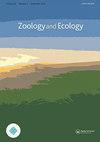北非红节骨顶(Fulica cristata Gmelin)繁殖生物生态学新资料
Q4 Environmental Science
引用次数: 1
摘要
本研究试图记录北非两个山地湿地红节骨顶(Fulica cristata)的繁殖生物生态学。在2018年和2019年的面包季节,每周在摩洛哥的Zerrouka和Hachlaf湖收集数据。2月至8月期间进行了实地访问。得到的结果表明,重要的繁殖种群在这两个地点定居。筑巢地点选择在Zerrouka地点的新兴植被上,而在Hachlaf湖,筑巢地点位于开阔水域。在两年中,两个地点的繁殖季节不同,而且每年的繁殖季节也不同:2018年,Zerrouka的繁殖季节为3月中旬至7月底,Hachlaf的繁殖季节为4月至8月中旬。2019年,Zerrouka的繁殖活动发生在1月至7月中旬,Hachlaf的繁殖活动发生在2月底至8月底。Zerrouka的巢和蛋相对大于Hachlaf,而Zerrouka的繁殖成功率(2018年约为33.3%,2019年约为39.8%)远低于Hachlaf(2018年为56.1%,2019年为54.7%)。本研究为北非红骨顶易危种群的繁殖生态研究提供了初步有意义的结果,为红骨顶的保护提供了依据。此外,所获得的结果将允许将来在西地中海盆地进行比较研究。本文章由计算机程序翻译,如有差异,请以英文原文为准。
New data on breeding bio-ecology of the Red-knobbed Coot (Fulica cristata Gmelin) in North Africa
This study attempts to document the breeding bio-ecology of the Red-knobbed Coot (Fulica cristata) in two North-African mountainous wetlands. Data were collected weekly in the Zerrouka and Hachlaf lakes in Morocco during the breading seasons of 2018 and 2019. Field visits were carried out between February and August. The obtained results showed that important breeding populations colonized the two sites. Nesting sites were selected on the emerging vegetation at the Zerrouka site, while at Lake Hachlaf nests were located in open waters. During the two years, the breeding season was different in the two sites and from year to year: in 2018, it was from mid-March to the end of July in Zerrouka and between April and mid-August in Hachlaf. In 2019, the breeding activity took place between January and mid-July in Zerrouka and between the end of February and the end of August at Hachlaf. Nests and eggs were relatively larger in Zerrouka than in Hachlaf, while the breeding success was much lower in Zerrouka (around 33.3% in 2018 and 39.8% in 2019) than in Hachlaf (56.1% in 2018 and 54.7% in 2019). In summary, this study provides the first significant results on the breeding bio-ecology of the vulnerable North African populations of the Red-knobbed Coot and allows formulating some measures for its conservation. Furthermore, the obtained results will allow future comparative studies in the Western Mediterranean basin.
求助全文
通过发布文献求助,成功后即可免费获取论文全文。
去求助
来源期刊

Zoology and Ecology
Agricultural and Biological Sciences-Animal Science and Zoology
CiteScore
1.00
自引率
0.00%
发文量
1
 求助内容:
求助内容: 应助结果提醒方式:
应助结果提醒方式:


